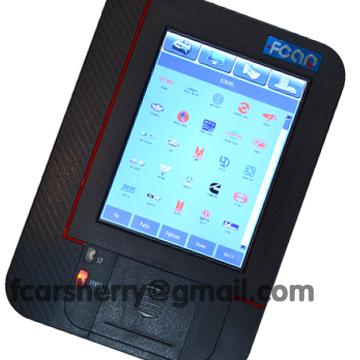How to check codes by OBD2 code reader
 What is OBDII?
What is OBDII?OBDII is a standardised diagnostics connector present on most modern cars which has a data stream containing lots of information such as known faults, fuel consumption, speed, engine rpm, throttle position, air flow, engine temperature, etc. Not only is this data really useful for tuning your engine and finding out how efficient your driving skills are but you can also use OBDII devices to reset check engine lights etc.
All cars sold in the United States after 1996 are required to be equipped with an OBD2 system. The OBD2 system monitors a car's performance and alerts the driver of current problems, as well as potential problems. An OBD2 scanner has to be connected to the car in order to retrieve the Diagnostic Trouble Codes (DTC) generated by the OBD2.
Determine whether your car is OBD2 compliant. A car that is OBD2 compliant will have a female 16-pin connector on the driver's side near the center console. Petrol vehicles manufactured as of 2001 and diesel vehicles manufactured as of 2004 should have this connector.
Prepare the equipment you will need. Depending on the type of OBD2 reader you will be using, you will need a personal OBD2 code reader and a cable, or a computer with OBD2 software, a converter and connectors (see Resources below). For your safety, your car engine must be off while you connect your OBD2 reader.
To get started, plug the scan tool into the OBD II connector under the dash. Turn the key on, but don't start the engine. The tool will ask for a number of things such as the VIN, the make and model of the vehicle and the engine type. Follow the onscreen instructions.
You'll get an option to check for trouble codes, as well as a couple of other menu choices. Some higher-end scan tools give you a text explanation of the code onscreen. Others give you a CD-ROM or just a paper pamphlet listing what the codes mean. Your best bet is to search the Web for a trouble-code list on a site that focuses on your particular vehicle-there will be information that might be far more helpful than just the code. When you read these codes, write them down before resetting the MIL indicator.
Inspection and maintenance (I/M) readiness will likely be another menu option. If you've turned off the MIL, your car needs to be driven until the PCM is sure that the fault has been corrected. How long? Every manufacturer has its own ideas, but a few days of normal driving should fulfill what are called I/M readiness tests. Why do you care? Because if you go to the DMV or an independent station for an inspection, the technician will plug in his own scan tool, and if your car hasn't passed I/M readiness, there'll be no sticker for you. I/M readiness is to keep people from sneaking a poorly running car through the emissions test by clearing codes just before pulling up to the DMV.
So far, an inexpensive code reader (less than $50) tells you all of this, and even lets you clear the codes and turn off the MIL light. Don't confuse a simple code reader-which is sometimes labeled a scan tool-with a genuine scan tool. A code reader, however, might be enough to catch most simple problems.
Advertise on APSense
This advertising space is available.
Post Your Ad Here
Post Your Ad Here
Comments